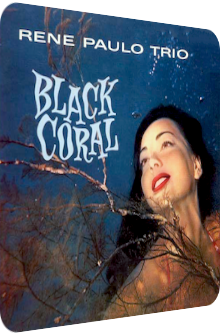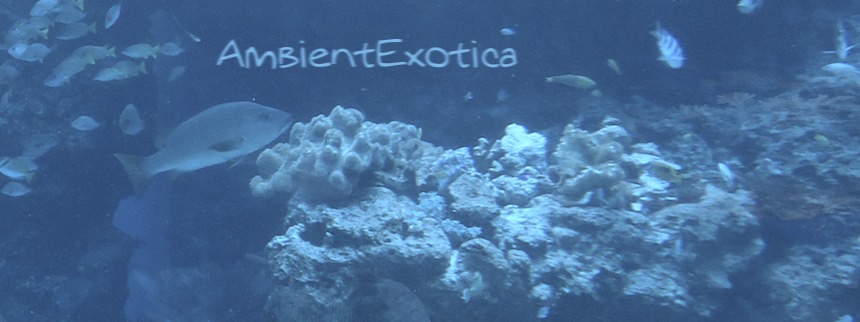
Rene Paulo Trio
Black Coral
1960
Black Coral is the exotic debut of the Hawaiian pianist and bandleader Rene Paulo (born 1930 in Schofield, Wisconsin), released in 1960 on Liberty Records and featuring twelve piano-focused works, one of them the eponymous title track written by Rene Paulo himself. Right from the start of his career, Rene Paulo tries to create and maintain the – undoubtedly veritable – image of a skilled Jazz musician rather than that of an entertaining Exotica aficionado. The title of the album already hints at the implied exclusivity: a black coral is a rare species, and Rene Paulo wants to link this status to his performances and records as well. He is a first-class luminary who outlives such mundane genres as Exotica. And indeed, Paulo performs throughout the decades to this day and has witnessed the rise, fall and resurrection of the beloved genre. During the late 50's and early 60's, many skilled pianists like Paul Conrad, Stanley Black and Rene Paulo find plenty of opportunities for gigs thanks to the Exotica craze. Even common Jazz combos feel the pressure to include sudden hits such as Quiet Village or Flamingo in their roster.
Rene Paulo resides more in the tradition of focused Jazz trios and quartets by presenting exotic material in a rather serious fashion without the use of exotic instruments. Black Coral is recorded at Henry J. Kaiser's Aluminum Dome in Honolulu, better known as the location where Arthur Lyman recorded all of his 50's albums. It evokes a moonlit tropical aura of enchantment, even in those cases where Paulo presents rapid sequences of piano tones. Paulo is accompanied by Ed Shonk on the double bass and Bruce Hamada on the drums, though the leader remains in the spotlight all the time. The percussion is not overly exotic, and yet does the nocturnal feeling of the LP evoke tropical nights in Hawaii. Since the album is so strongly determined by the piano, it surely is not suitable for every Exotica fan. There are, however, a few gems in-between that coral which are pried out by me below.
Rene Paulo’s debut is rooted in traditional songs. The first two renditions of the album show this better than anything. They are dedicated to Maui, Hawaii’s second largest island. Maui Chimes is a rather fast-paced tune with an utter focus on Rene Paulo’s pianistic skills, and while this tune does not yet evoke the nightly beach walk right from the get-go, the middle section of it succeeds big time due to Bruce Hamada’s soft cymbal-driven percussion scheme, Ed Shonk’s careful bass underlinings and Rene Paulo’s decision to drop way less piano tones per second than before. The result is the expected and languished moonlit aura, reached through minimalism. This despite the fact that Maui Chimes is actually a sun-soaked piece, at least in the hands of Arthur Lyman on his 1959 album Bahia. The following Maui Girl, on the other hand, does exactly depict the effervescent luminescence of the sun with the help of jumpy piano notes, carefully added chords for euphonious purposes and short moments of percussive interludes. Yet again does Rene Paulo’s arrangement change the daytime later on with the same trick by decreasing the keys per second and thus decelerating the perceived tempo.
Don Reno’s and Red Smiley’s Sweetheart Mine (its original title being No Longer A Sweetheart Of Mine) is a wondrous piano arrangement without any traces of percussion, a feat Paulo would repeat on all of his successive albums as well. The glissando of the tones resembles aqueous cascades, the warmth of the timbre and the complete silence in the background make this a transformative, highly mesmeric piece that induces innocence and carefreeness. While the take on Johnny Noble’s Hawaiian War Chant shows the true craftsmanship of any writer who uses the piano as the starting point of a composition, with Paulo revving up the tempo to rapid-firing dimensions full of firefly-like dancing piano sparkles and hectic percussion layers, it is Jack Owen’s Hukilau Song that shows the first flaw of Paulo’s piano-focused approach. Sure enough, a good melody cannot be destroyed and always works on any device, but the improvisational skills of the pianist dilute the catchiness, resulting in a song that is almost unrecognizable in this state. And since Owen’s song comprises of a particularly strong melody that is easily hummable, the labyrinthine eclecticism of this rendition is all the more inept.
Bill Cogswell’s, Johnny Noble’s and Tommy Harrison’s My Little Grass Shack is thankfully unharmed by any convolution, although the bandleader oscillates between Honky Tonk schemes and wonderfully auroral chords. This duality does the song good, as do Bruce Hamada’s infinitesimally interwoven hi-hats. A dreaminess can definitely unfold.
Side B opens with another traditional Hawaiian song. O Makalapua is a feast, utterly enchanting and enormously snugly. This is the most languorous downtempo piano arrangement on the album, evoking a soft breeze of tropical winds with a mirage of solemn chords. This one ought to be reserved for contemplative or romantic nights on an island. Paulo keeps a streamlined approach and, for a change, does not fall prey to short outbursts or experimental interludes. No, O Makalapua is awash with moonlight from the beginning till the end. Whereas the pianist’s interpretation of Rantaro Taki’s Hana continues the path of mellowness and only adds traces of rhythmic tercets in lower tone regions, Rene Paulo’s own eponymous Black Coral is a splendidly warm power ballad loaded with wave-like piano spirals which augment the perception of a liquid arrangement. Of further note are the many jumps between the tone regions; thanks to the glissando and meandering structures, the listener does not perceive these jumps as, well, jumpy or choppy, and so Black Coral remains a harmonious tune.
The traditional Ono Ono is undoubtedly the jazziest tune of the album, with all members on board playing a vivid tune with multitudinous sound intensity shifts, manifold timbres that range from dulcet to vigorous and a lot of melodies. Ono Ono feels more like a continuous stream of different vignettes than a single track, but each section is varied and full of esprit. Sam Koki’s Nani Waimea is another great offering with lots of piano spirals, double bass accents and percussion schemes. Being the shortest tune of less than two minutes, the performance nonetheless feels never rushed, its upbeat tempo is enlightening, the melodies joyful yet able to transport the listener into Polynesian spheres should he or she not reside there physically already. The outro is an interpretation of Charles E. King’s Song Of The Islands, and boy, is it great! The melodies are kept intact, the tempo is slow, the mood totally enchanting. Each piano note glows, the lucency is large, the tones feel like scintillae that illuminate the night. Here the reduction works flawlessly: despite the many orchestral takes of this classic, Rene Paulo can take a stand and is able to advect the whole magic into this arrangement. A superb closer!
Fans of the Exotica genre are used to a wide variety of instruments, swirling melodies and a birdcall or two on many albums. The Rene Paulo Trio breaks with these traditions and underwhelms the expectations. Paulo's debut is a meticulously focused piano album, and even if the pianist allows his band members Ed Shonk and Bruce Hamada to accompany his virtuous performance, this usually happens in a quiet, truly accentuating way. In a way, Black Coral shows the eleven renditions and Rene Paulo's own track under a magnifying glass similar to Stanley Black's Tropical Moonlight (1957) and Cuban Moonlight (1958). The piano is the point of origin of virtually all vintage composers. Once a melody works on this instrument, it is certainly successful in other arrangements and transformations.
Since Hawaiian listeners were well familiar with the majority of the 12 songs, the trio decides to spice them up, especially Paulo unleashes huge amounts of improvised tone sequences, spirals, cascades and maelstroms that undoubtedly show his capabilities, but lead away many times from the lead melodies. Nowhere is this more apparent than on the trio's take on Jack Owen's Hukilau Song. The world-famous exhilarative melody is camouflaged and quite hard to recognize. This observation can of course be formulated in a positive way: Rene Paulo is not keen on delivering the compositions in the same old fashion, but wants to show his craftsmanship. In this regard, Black Coral belongs much more clearly to the Jazz realms than even Martin Denny's piano arrangements.
Should Exotica fans check the album out nonetheless? Yes, if not the whole album, then at least the dreamy, wonderfully silky piano constructions that work fantastically well when the time and listening conditions are right. I prefer to listen to this album at nighttime, whereas Paulo's foil Tropical Heat Wave from 1963 is more of a daytime artifact. Luckily, Black Coral is available on iTunes and Amazon, so you can pre-listen to the tracks if you do not know them already. Be aware though that the song order has been horribly mixed up and the sound quality is audaciously muffled, making the percussion sections seem even smaller than they already are. I hope for a digital edition that is based on the master tapes.
Exotica Review 234: Rene Paulo Trio – Black Coral (1960). Originally published on Jul. 6, 2013 at AmbientExotica.com.
